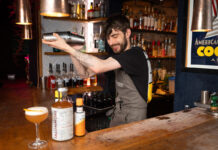Customers are keen to try new brands and new serves, say drinks firms
With a plethora of new gins hitting the market from both the big drinks firms and the small batch producers, publicans have never had more choice when it comes to stocking their back-bar.
 And the boom shows no sign of stopping, according to gin makers.
And the boom shows no sign of stopping, according to gin makers.
Paul Donegan of Pickering’s Gin is confident there’s still a way to go before growth in the sector reaches a plateau.
“The gin category is certainly growing and we don’t see this slowing down,” said Donegan.
“We can’t really speak for the entire category but we are doing our best to increase our own sales this year.”
Alex Nicol of The Spencerfield Spirit Company, the firm behind Edinburgh Gin, said gin growth is being driven by consumers who “range from just enjoying experimenting with various brands, to really wanting to know everything about the gin they are drinking”.
Martin Murray of Rock Rose gin agreed that consumer engagement and a willingness to experiment has been key to driving gin sales.
“Consumers are very open to trying new gin brands,” he said.
“Once they know more about the people behind the brand, and the botanical details, they are normally very keen to try it.”
Stuart McMillan, distillery manager at Strathearn distillery, said that consumers are “definitely looking for points of difference between all the brands on the market”, while Miranda Hayman of Hayman’s Gin highlighted the pursuit of quality as the motivator behind consumers experimenting with gin.
“Firstly, customers, specifically gin drinkers, are looking for a quality gin,” said Hayman.
“There’s also an element of discovery that people enjoy and embrace, perhaps trying gins that they might not have heard of or tasted before.
“Consumers appreciate a story behind the gin and gin lovers are increasingly interested to try new styles so it’s important that bars appeal to this informed group by offering a range of gin styles.”
Exploration in the gin category was also highlighted by Will Holt of Pinkster Gin, who said consumers have shown a “continuing sense of adventure when it comes to trying new gin brands”.
“The back-story to a brand carries considerable clout,” he said.
Story and provenance play a large role in determining how consumers choose their gin, according to Vivienne Muir of NB Gin, who said drinkers like to know where their brand comes from, who made it and “if there’s a story behind it”.
“They want something different to the norm that isn’t stocked everywhere else,” said Muir.
Provenance helps, but it’s not the only thing driving more consumers towards gin.

Muir reckons the return of “cocktail culture” has also helped broaden the spirit’s appeal.
“Gin is at the base of some of the greatest and most classic cocktails, and many people are favouring gin over vodka when it comes to ingredients,” she said.
“Even the way people talk about gin has really changed, with people asking each other ‘what’s your tonic’ and discussing the varying use of botanicals and garnishes, which are almost becoming trademarks in their own right. Gin is fashionable.”
Cocktails may have gained renewed prominence in the on-trade, but publicans shouldn’t ignore the classic G&T either, suggested Jon Sampson, brand manager for Bombay Sapphire in the UK.
“The classic gin and tonic serve continues to be a key driver of gin, especially during the summer,” said Sampson.
“Not only is the traditional gin and tonic a great sales driver, many bartenders have been putting their own twist on gin and tonic with new flavours and garnishes to offer customers something a little different.”
Getting a good gin in your G&T is great, but operators should also be careful to offer customers a choice of tonics to meet their tastes, suggested Luke Benson of soft drinks company Fever-Tree.
“Bars should now be realising that the everyday consumer is becoming more discerning and more conscious of what they are drinking,” said Benson. “As such they expect bars to at least have a choice.”
Jacqueline Sutherland of Wemyss Malts, the firm behind Darnley’s View gin, agreed that publicans should make “quality tonics more readily available”, as did Frazer McGlinchey of Caorunn Gin, who said the better the tonic “the better the end product” when serving a G&T.
“It is a simple classic drink but so much more memorable when done well, and with attention to detail to engage consumers and create an experience,” said McGlinchey.
There’s a well trodden path to the traditional gin and tonic, and although it remains popular for a reason, the next big hit with your customers may be something entirely new, according to Mike Hayward, director of the Glasgow Distillery Company, the firm behind Makar.
“Beyond the G&T, there is definitely an appetite to explore new gin serves,” said Hayward.
“From an operator perspective it is important to recognise what style of serve and flavour profiles are popular with their consumers as this will drive greater interest and sales.”
A quality serve is crucial to long term success, but for that first serve, staff engagement is still vital, said Ashley Moore, category development manager at Diageo, the firm behind Gordon’s and Tanqueray.
“Get your staff involved – it will fuel their interest in the drinks you serve and make them really feel part of the business,” said Moore.
“If your staff are inspired about what they’re serving, they will be able to make more engaging recommendations to customers, equalling more profit for your outlet.”



















